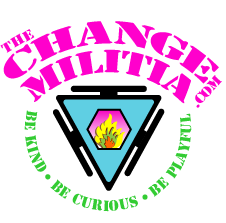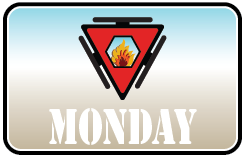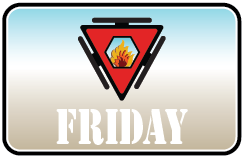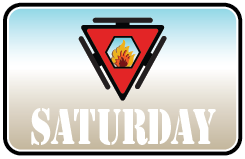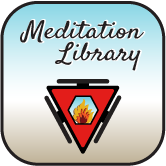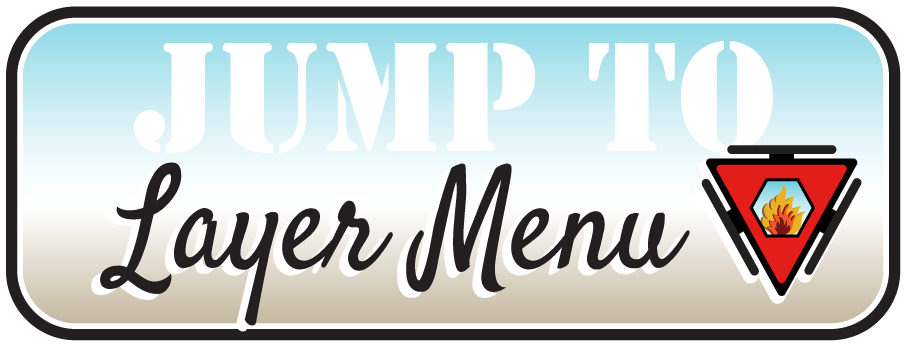Layer Four, Week Three – Sunday
- Morning – Watch Videos and Read Instructions Filling the Balloon and Leg Swing
- Evening – Read Layer Four, Week Three Concepts
- Evening – Practice Leg Swing
Sunday’s Focus
Last week you focused on your balance. This week you will focus on your ability to focus and your stability. Start by tracking how present you feel. Can you exist in every moment without fidgeting, getting impatient, or interrupting? How easy is it for you to relax regardless of what is going on around you? Does it seem like your mind, body, and emotions are on the same page?
Sunday’s Concepts
The second component of balance is Stability. When you think of stability you might think of something constant, fixed, or unchangeable. The stability we will talk about is being centered, present, and accepting. Stability is rooted in actuality and reality. Stability connects and unifies. Unwavering would be another great description. Accepting and allowing what is without expectation, demand, or judgment. Stability has no sense of entitlement. Stability is effortless existence.
How patient are you? Patience is a function of stability. When you aren’t expecting or demanding change, patience happens. When you are being judgmental, you are unstable because you want something to be some different than it is. Kelly was gone, travelling, for two months. Almost the entire time, I was some degree of unstable because I didn’t want her to be gone. It influenced all my other energies. I had less physical, mental, emotional, and environmental energy than I would have had if I didn’t have that semi-conscious demand that she be here. Sometimes you won’t be able to stay completely balanced. Looking back on the last couple of months there would have been lots of things I could have done more effectively.
I could have been more social, exercised more vigorously, spend more time outdoors, eaten healthier, and been much more playful. All of those are ways I typically stay stable and balanced. When she was gone, I chose to limit them. I wanted to want her. Parts of me wanted to be unstable because it was manageable. The resentment I felt was something I could hold onto, ruminate about, and recirculate. My instability allowed me to tolerate her being gone without overwhelming my system. I allowed myself to wallow in mediocrity because that is where my subconscious mind felt safest.
Layer Four, Week Three – Monday
- Morning – Practice Filling the Balloon
- Morning or Evening – Read Monday Concepts
- Evening – Practice Leg Swing
Monday’s Focus
Today, watch and assess the people around you. Rate their overall balance (in your head) from 1-10. How focused and stable do they seem? Are they alert or distracted? Do they feel relaxed or tense? Do they feel present or like they are somewhere else? Don’t share your observations with them, just watch and assess.
Monday’s Concepts
Stability is easiest to identify when it is not present. It is easy to feel when you or someone else is mentally or emotionally unstable. Their energy is frenetic, unpredictable, and usually volatile. Stability is the opposite of that. When you are stable, you accept and acknowledge what is present without a demand or expectation that it be different. Stability is cohesive; when you are stable, you can hold it together, not come unglued. Stable people stay centered and present. Stability is ease and belonging, the feeling that all is right with the world.
Feel back to the last time you or someone around you was unstable. Can you identify which of your, his, or her bodies was not centered? Did it feel mental, emotional, or physical? Did it feel like the energy wasn’t centered or was scattered?
Mental instability comes across as bullying, coercing, manipulating, or pleading. The instability creates a demand for the present moment to be different in some way. Have you ever been in a conversation, debate, or argument with someone who can’t stop talking or refuses to engage? They are mentally unstable.
When you get mentally unstable, what configuration does our energy take? Do you bully, sulk, spew, space out, seduce, or something else? Consider the people in your life; what is their pattern?
Think back to a time when you were mentally unstable; stress is a prevalent example. What do you do with your stress? How do you let it create instability in your systems? What configuration do your thoughts take when you get stressed? Do you think about the past, future, or present? Do you create alternate scenarios or go into blame? Do you worry, get angry, or pout?
Layer Four, Week Three – Tuesday
- Morning – Practice Filling the Balloon
- Morning or Evening – Read Tuesday Concepts
- Evening – Practice Leg Swing
Tuesday’s Focus
Feel your physical body throughout the day. Feel for focus and stability. A stable and focused body is a relaxed body. Where are you tense? Where does your body hold stress? What parts of your body feel disconnected or out of touch? Where do you feel numb? What feels hyper-sensitive? Does it feel like your weight is centered around your low belly or your head? What aches and pains draw your attention (and inhibit your ability to focus)?
Tuesday’s Concepts
Emotional instability is easy to feel or identify. Some people get outwardly emotional, histrionic; others turn inward and get quiet (like me). As you get in touch with your energetic or subtle body, you will be able to feel (if you can’t already) where your and other’s emotional energy is centered.
What is your default? When you get emotionally unstable, where does your emotional energy feel like it is? It might be in front, above, beside (“I’m beside myself”), or at any other angle. Highly emotional people generally project their emotional energy in front of them. You might compress it into your body somewhere (low belly, low back, heart, throat, or somewhere in their skull) or scatter it in every direction like a sparkler.
Every aspect of stability has an environmental body component because you are stable in contrast or collaboration to something else. Physical environmental stability is whatever you are in physical contact with (ground, bike, roller blades, horse, sailboat, etc.). Mental environmental instability usually happens when you compare your thoughts and beliefs to someone else’s. Emotional environmental stability is usually regarding your relationships with others or past events that include others.
Feeling alone is an emotional environmental instability from lack of connection to others. Mental environmental instability is the judgment that something or things in your environment does not meet your expectations or demands.
Layer Four, Week Three – Wednesday
- Morning – Practice Filling the Balloon
- Morning or EveningEvening – Read Wednesday Concepts
- Evening – Practice Leg Swing
Wednesday’s Focus
Track how mentally focused and stable you are during the day. When you have trouble mentally focusing, what do you do and how do you get there? What draws you out of being focused. What does it feel like to feel focused and how does that transition to unfocused? How does it destabilize you when you lose focus? What does mentally unstable feel like?
Wednesday’s Concepts
Third on the list of components is Speed. The primary ingredients in speed are momentum, technique, and purpose. Momentum is the kinetic energy something has because it is moving. Technique enables efficient progress (the more efficient you are, the more progress you will make with the same amount of energy expended). Technique is concise, proficient, and facile. Purpose sets your direction with resolution and a frame of reference. Purpose is what allows you to move from zero, it gets you out of the gate.
Physical speed results when an object’s kinetic energy overcomes its inherent resistance. The speed in which you reach success, happiness, and fulfillment increases as you mitigate obstacles and drag with your increased momentum. Improving your technique allows your speed to increase with a reduction in your energy expenditure. Purpose is speed’s procreation and conception. Purpose allows the speed you have created to continue to exist.
You go fast to the degree that you have determined your trajectory (purpose and direction), challenged yourself to maintain your technique, and identified your frame of reference (intermediate goals).
Human development (changing the world) through personal development (changing yourself) happens much more quickly the faster we go. Speed is essential for dynamic change. The hardest part of any task is getting started, overcoming inertia. Momentum takes inertia out of the picture. You get going and you keep going.
Layer Four, Week Three – Thursday
- Morning – Practice Filling the Balloon
- Morning or Evening – Read Thursday Concepts
- Evening – Practice Leg Swing
Thursday’s Focus
During the day, feel into your emotional focus and stability. What influences your emotional stability? Do you lose your emotional focus by going into story creation or drama? When can’t you be empathetic? What degree of emotional expression is okay for you and what degree is okay for others? When is emotional expression not okay? What judgements do you have about your emotional expression? When do your emotions cause you to lose mental focus?
Thursday’s Concepts
Move fast, think faster! The speed of your mental body must match or exceed the speed of your physical body (to move efficiently requires that you mentally decide which action is most beneficial). Thinking quickly requires that you can disregard obstacles, reduce your images and beliefs (drag), and limit your distractions. You need to think as fast or faster than you move.
Your mental body helps you monitor your technique and its accompanying efficiency. It helps to track your proficiency and if you let it, helps you to celebrate successful movements which increases your momentum. Your conscious mind helps to maintain speed by limiting distractions (obstacles and drag) and helping to keep your frame of reference (intentions and trajectory).
Your emotional body finds fluid balance in speed by allowing momentum (not stopping you when things start to get intense). Your purpose will lead to emotional proficiency and your emotions will flow effortlessly. Emotional speed happens to the degree you don’t put on your emotional brakes. Once you realize that you have emotional brakes that cause emotional breaks, it becomes much easier to reduce the pressure on the pedal, to allow emotions to flow.
Layer Four, Week Three – Friday
- Morning – Practice Filling the Balloon
- Morning or Evening – Read Friday Concepts
- Evening – Practice Leg Swing
Friday’s Focus
Monitor your ability to focus on your environment throughout the day. How aware are you of your surrounding and the people in it? How easy is it for you to acclimate to changing currents of energy, conversation, and location? How deeply do you listen? How easily are you distracted or pulled out of your center by the goings on around you?
Friday’s Concepts
Energetic speed is all about your rate of vibration and how open your energy channels are (more on this later). Passion, creativity, happiness, and curiosity have a very high vibrational rate. Confusion, insecurity, and boredom have low vibrational rates.
Ever notice how easy it is to go for a run, do the dishes, or start a new project when you are happy, excited, or passionate? Moving energy tends to stay moving. Stagnant energy tends to stay stagnant. Energy moving at any given vibration tends to want to stay at that vibration. (Newton’s first law of motion)
If you can modify your behaviors and habit to create stability, your speed and level of vibration will be easier to maintain. It will be easier to retain your momentum and increases in your momentum will make acceleration easier. As you adapt to a greater speed and vibration, you will tend to stay at that elevated speed and vibration. Effortless success and happiness is a function of habit and intention. Raise your vibration and keep elevating your presence.
Layer Four, Week Three – Saturday
- Morning – Practice Filling the Balloon
- Morning or Evening – Read Saturday Concepts
- Evening – Practice Leg Swing
Saturday’s Focus
Review your week. How focused and stable did you feel most of the time? Can you pinpoint the kinds of things that raised or lowered your focus and stability? Can you identify some of your triggers that led to instability and loss of focus?
Saturday’s Concepts
Environmental speed is how quickly you can metabolize the energy of your environment. Some of your relationships feel much more effortless than others. When you get super excited to see an old friend and you instantly fall into familiar joyful and affectionate patterns, you are quickly digesting their energy and vice versa. Some relationships are efficient, you have let go of your resistance, and there is residual momentum that keeps things moving.
You are going along, minding your own business and you get an idea for a new widget gizmo. You get home and tell your significant other and he or she gets as excited as you are. You continue to talk about it to your friends, you post it on Facestagrawitterest and the excitement builds. You start a GoFundMe campaign and collect enough cash and build a prototype. Your idea has become a reality. The energy of your idea has converted to mass. The idea required sufficient speed to overcome the inertia of the resistance you faced. Nicely done!
Environmental speed is also about how efficiently you receive energy from the people and things around you. Imagine what would have happened in the above scenario if you didn’t accept the praise and excitement from your partner, or chose not to take the cash raised. The prototype wouldn’t exist … or it wouldn’t have existed quite as quickly.
That’s it for speed. Next week, we begin by looking at the component of Strength.
Filling the Balloon
Step 1 – Do a Current30 and then to an Environmental30 where you identify the energies in your vision.
Step 2 – Take a few deep, clearing breaths and allow yourself to soften. Sequentially relax body parts with each exhale starting at your feet, then your legs, hips, low back, low belly, hands, arms, diaphragm, chest, back, shoulders, neck, and head.
Step 3 – Breathe normally and begin to feel you environment. Start simple like the air temperature, air movement, air pressure, sunlight, sounds, heat, etc.
Step 4 – On every inhale imagine what it would feel like to pull all of the ambient or environmental energy into your space (energy field) from every direction and every element around you.
Step 5 – As you exhale, gently restrict the movement of air through your throat (Darth Vader breath) and imagine the energy that you have collected being brought into your body through your low belly (Hara Point).
Step 6 – Pause at the bottom of the exhale until you feel or imagine that the energy has transferred.
Step 7 – Repeat repeatedly.
Step 8 – Allow the energy to fill your energetic balloon and allow your balloon to get bigger.
Why it Matters – The amount of energy you have available to consistently and sustainably share is wholly dependent on how efficient and effective you are at bringing energy into your system. This breathing technique is the start of your journey to increasing the size of your container (balloon) and multiplying your potential influence and impact.
Everyday Usability – This is a vitalizing and revitalizing breathing technique. Use it anytime you feel unbalanced, frenetic, or mentally, emotionally, or physically exhausted this will help you to rebalance and energize yourself.
Progression – Try increasing your respiration rate (breathe a little faster) and increase your intention to “push” the energy into your system. Add physical movement (kind of like I do in the video). Add bigger physical movements (do this standing and exaggerate the movements).
Leg Swing
Step 1 – Find something to stand on about as big as your foot, 3-5” high and fairly stable.
Step 2 – Step up on your block with one foot and get your balance. If necessary, rest one hand on a wall or countertop.
Step 3 – Notice how your balance changes, how you compensate by shifting your hips over the standing leg.
Step 4 – Stand balanced on one leg and notice the momentary shifts your body does to help you stay balanced. If you are supporting yourself with a hand on the wall, lightly touch the wall and let your hand float off of it as much as possible. Supporting yourself is a major compensation
Step 5 – See how comfortable, stable, and relaxed you can get standing on one leg. It may help to pick a spot 6’-8’ in front of you to focus on.
Step 6 – Begin to move by opening and closing your hip. Notice what you do physically to help you maintain your balance. Feel as many body parts as possible and realize that they all help react in some way.
Step 7 – Move in several other ways and detect as many compensations as you can.
Step 8 – Switch legs and repeat. Be aware of the difference in sensation and compensation.
Step 9 – Get wild, see what you are capable of. As you move through the week, challenge yourself, challenge your ability to balance and challenge your ability to identify your physical compensations.
Why it Matters – Compensations are how you lower your vitality, minimize your expansion, and restrict your ability to be intimate, connected, and engaged. This exercise focused on your physical compensations but a majority of your energy is lost in your mental, emotional, and environmental compensations. Feel into how much energy you spend thinking about what is going on around you. How much emotional energy do you exert on projections, assumptions, and drama? Learn to detect the sensations from your physical compensations and they will help you detect your other compensations.
Everyday Usability – If compensations leave you fatigued, distant, and unproductive; as you identify them try doing something different. Lower the intensity of your compensations; see what it feels like to lean into a conversation instead of pulling away.
Progression – Try increasing your presence instead of limiting it. Be more playful, laugh more easily, and tell people how much you love and appreciate them. Be warm and affectionate. Test your edges. Soften into intimacy and connection instead of steeling yourself. Look for opportunities to be kind and act accordingly.
